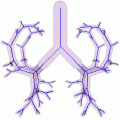You are here
3D Thinning Algorithms

Skeleton is a region-based shape descriptor which summarizes the general form of objects/shapes. An illustrative definition of the skeleton is given using the prairie-fire analogy: the object boundary is set on fire and the skeleton is formed by the loci where the fire fronts meet and extinguish each other.
Thinning is a frequently used method for making an approximation to the skeleton in a topology--preserving way. It is based on a digital simulation of the fire front propagation: the border points of a binary object that satisfy certain topological and geometric constraints are deleted in iteration steps. The entire process is then repeated until only the "skeleton" is left.
There are two types of 3D thinning algorithms: the curve--thinning type is used to extract medial lines or centerlines, while a surface--thinning type produces medial surfaces. We proposed various 3D thinning algorithms capable of extracting medial lines or medial surfaces as well.
Examples of different types of skeletal shape features in 3D:



The original object (left), its medial surface (middle), and its medial lines (right).
